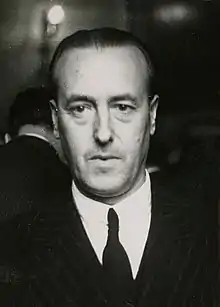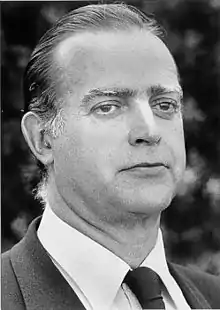Organización Sindical Española | |
 | |
| Founded | 26 January 1940 |
|---|---|
| Dissolved | 6 December 1977 |
| Headquarters | Casa Sindical, Madrid |
| Location | |
Members | All employed citizens |
Key people | See Leadership section |
| Publication | Pueblo |
| Part of a series on |
| Francoism |
|---|
.svg.png.webp) Eagle of Saint John |
|
The Spanish Syndical Organization[1][2][3] (Spanish: Organización Sindical Española; OSE), popularly known in Spain as the Sindicato Vertical (the "Vertical Trade Union"), was the sole legal trade union for most of the Francoist dictatorship. A public-law entity created in 1940, the vertically-structured OSE was a core part of the project for frameworking the Economy and the State in Francoist Spain, following the trend of the new type of "harmonicist" and corporatist understanding of labour relations vouching for worker–employer collaboration developed in totalitarian regimes such as those of Nazi Germany and Fascist Italy in the first half of the 20th century.[4] Up until the early 1950s, it internally worked—at least on a rhetorical basis—according to the discourse of national syndicalism.[5] Previous unions, like the anarchist CNT and the socialist UGT, were outlawed and driven underground, and joining the OSE was mandatory for all employed citizens.[6] It was disbanded in 1977.
History
The OSE was founded in 1940, established in a January 1940 Law of "Syndical Unity", while its structure was developed through a December 1940 law, in which the OSE was defined as subordinated to the (single) party.[7] Its ideological fundamentals date back to the 1938 Fuero del Trabajo law.[8]
OSE held its first congress February 27, 1961 – March 4, 1961. The organisation itself claimed to have roots in the trade union activity of the National-Syndicalist Workers Central (CONS), founded in 1935. CONS had been, as a result of the Unification Decree between the Falangists and the Carlists in 1937, fused with the National-Syndicalist Employers Central (CENS) into the National-Syndical Centrals (Centrales Nacional-Sindicalistas). The idea of organising workers, technicians and employers within one "vertical" structure was also integrated in OSE, and the CNS were incorporated into OSE.[9]
At the very beginning of the Francoist State, wages were directly fixed by the state and only later could workers and employers agree upon their wages through this vertical union. This organisation was the practical consequence of the fascist ideal for industrial relations in a corporate state. In it, all the workers, called "producers," and their employers had the right to choose their representatives through elections.
In this organisation, workers and employers supposedly bargained equally. Strikes were forbidden and firing a worker was very expensive and difficult, as the fascism had "bettered capitalism" and had "succeeded in harmonically balancing workers' and employers' interests". In reality, candidates for these elections had to be approved by Francoist Spain and all the process was heavily controlled, as fascism had a very interventionist policy towards the labour market: full employment for men, even at the expense of low wages or inflation, almost no right to work for married women and no unemployment benefits at all.
At the very end of the Francoist State, the sindicato vertical lost its always limited power and illegal trade unions gained force. This led some pragmatic employers to deal with these illegal unions and forsake the "vertical" one. It disappeared in 1977, during the Spanish transition to democracy.
Clandestine PCE presence
The banned Communist Party of Spain (PCE) considered that the "union" was heavily lopsided in favour of capital but was there to stay, and decided to infiltrate it with their candidates in order to achieve practical gains for the workers' conditions. This was the basis for the communist Workers' Commissions.
Leadership
| No. | Portrait | Name (Birth–Death) |
Term | Political party | ||
|---|---|---|---|---|---|---|
| Took office | Left office | Time in office | ||||
| National Delegates | ||||||
| 1 | Gerardo Salvador Merino (1910–1971) | 9 September 1939 | 13 September 1941 | 2 years, 4 days | National Movement | |
| – | Manuel Valdés Larrañaga (1909–2001) Acting | 13 September 1941 | 18 December 1941 | 96 days | National Movement | |
| 2 | Fermín Sanz-Orrio (1901–1998) | 18 December 1941 | 7 September 1951 | 9 years, 263 days | National Movement | |
| 3 | José Solís Ruiz (1913–1990) | 7 September 1951 | 29 October 1969 | 18 years, 52 days | National Movement | |
| 4 | Enrique García-Ramal (1914–1987) Cabinet-level official in the Franco VIII Government | 29 October 1969 | 11 June 1973 | 3 years, 225 days | National Movement | |
| Ministers of Trade Union Relations | ||||||
| 1 | Enrique García-Ramal (1914–1987) | 11 June 1973 | 3 January 1974 | 206 days | National Movement | |
| 2 | Alejandro Fernández Sordo (1921–2009) | 3 January 1974 | 11 December 1975 | 1 year, 342 days | National Movement | |
| 3 | Rodolfo Martín Villa (born 1934) | 11 December 1975 | 7 July 1976 | 209 days | National Movement | |
| 4 | Enrique de la Mata (1933–1987) | 7 July 1976 | 4 July 1977 | 362 days | National Movement | |
See also
References
- ↑ Witney, Fred (1966). "Labor and the Spanish Syndical System". Monthly Labor Review. 89 (8): 867–870. ISSN 0098-1818. JSTOR 41836594.
- ↑ Foweraker, Joe (1987). "Corporatist Strategies and the Transition to Democracy in Spain". Comparative Politics. 20 (1): 57–72. doi:10.2307/421920. ISSN 0010-4159. JSTOR 421920.
- ↑ Campbell, Joan; Windmuller, John P. (1992). European Labor Unions. Greenwood Publishing Group. ISBN 9780313263712.
- ↑ Giménez Martínez 2015, pp. 223, 232.
- ↑ Soto Carmona, Álvaro (1995). "Auge y caída de la Organización Sindical Española" (PDF). Espacio Tiempo y Forma. Serie V, Historia Contemporánea. Universidad Nacional de Educación a Distancia. 8.
- ↑ Barred, Mikel (2006). La Democracia española: realidades y desafíos. Análisis del sistema político español. Open University of Catalonia.
- ↑ Lieberman, Sima (2013-11-05). The Contemporary Spanish Economy: A Historical Perspective. Routledge. ISBN 9781136590351.
- ↑ Giménez Martínez, Miguel Ángel (2015). "El sindicalismo vertical en la España franquista: principios doctrinales, estructura y desarrollo". Revista Mexicana de Historia del Derecho. Mexico: UNAM. XXXI: 228. doi:10.22201/iij.24487880e.2015.31.10213 (inactive 1 August 2023).
{{cite journal}}: CS1 maint: DOI inactive as of August 2023 (link) - ↑ Organización Sindical Española, Escuela Sindical 1961. Madrid: 1961
![Gerardo Salvador Merino [es]](../I/No_image.png.webp)

_Discurso_del_ministro_del_Movimiento_Jos%C3%A9_Sol%C3%ADs_en_el_cincuentenario_del_Cabildo_de_Gran_Canaria_(cropped).jpg.webp)
_Adolfo_Su%C3%A1rez_conversa_con_el_lehendakari_del_Gobierno_Vasco_en_presencia_del_ministro_de_Administraci%C3%B3n_Territorial_en_el_Palacio_de_Ajuria_Enea_-_Pool_Moncloa_(1980-12-09)_(cropped).jpeg.webp)
